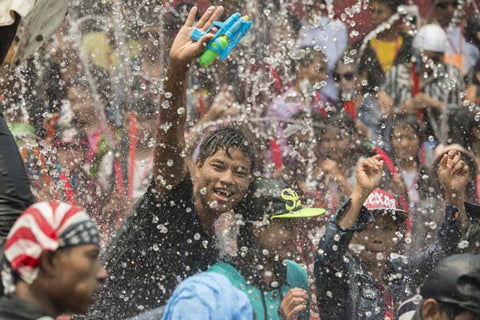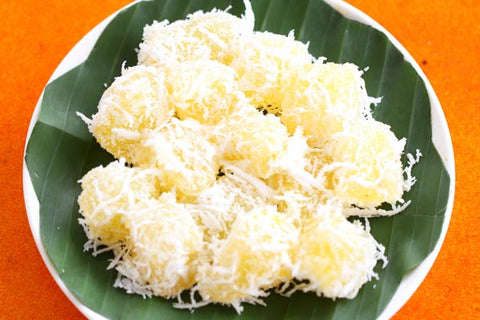How to Celebrate Burmese New Year, Thingyan, With MiMi Aye
by Holly Thomson

Food writer MiMi Aye explains how to celebrate Thingyan, and describes the (sometimes surprising) dishes enjoyed as part of the Burmese New Year celebrations. Burmese Thingyan is celebrated in April, and is also referred to as the Water Festival.
MiMi is the author of two cookbooks, Noodle! (100 Great Recipes), and Mandalay: Recipes & Tales From A Burmese Kitchen, both published by Bloomsbury Absolute.“When I was growing up, the UK’s Burmese population was fairly pocketed across the country as the diaspora was made up of medics who had been posted all around – at one point, my family were in Wales.
There wasn’t really a cohesive community, so we’d try to get together any way we could for New Year. And - this sounds a bit posh but I promise it wasn’t! - we’d normally gather at the Ambassador’s house in London.
He threw a big garden party, all our Burmese friends would be there, his wife would put on a massive spread and there would be Burmese singers and dancers.
How to celebrate Burmese New Year, Thingyan
- Water is a really important part of Thingyan. In Burma, and other countries that celebrate New Year then (like Thailand's Songkran and the Lao Republic's Pi Mai), April is the hottest month of the year. So the water is a way of cooling down, as well as a religious cleansing.
- Thingyan is a three-day celebration and gets progressively more raucous as it goes on. By day three people have got the buckets and hose pipes out. You definitely don’t want to wear anything see-through!
- But in the UK in April it’s a bit colder, and the water element was a bit more traditional at the Ambassador’s parties. We had a big engraved silver bowl with scented spring water. You dip in a yellow flower (the Burmese padauk blossom), then gently flick it at people in a delicate manner to bless them for the year ahead.

What food to make at Thingyan: Mont Lone Yay Baw & Thingyan Rice
There are two main dishes specifically for Thingyan.
1. The first is a rice flour dumpling, in which you put a piece of palm sugar jaggery. You roll it up and boil it, and the dumpling will rise to the top of the pot when it’s ready. It’s called mont lone yay baw, which literally means ‘round snack that floats’.
They’re similar to the Malaysian onde onde and also a little like Japanese mochi. They go all gooey and lovely. You grate over coconut to finish, and serve them on banana leaves.
And here’s the naughty bit. In every tenth dumpling you put a Bird’s Eye chilli instead of jaggery! So when you hand them out to friends and family, every tenth person gets a chilli. It’s Russian roulette…!
But the dumplings really are something that everyone makes, it’s very communal. You get rolling parties with massive tubs of the dough and huge trays of sugar that everyone sits around.

2. The second specific Thingyan dish is one I have to admit I haven’t actually tried. It’s a lower Burma treat and I’m from upper Burma. It’s simply called Thingyan rice, and is made with paraffin wax, dried fish, with mango and plum pickles. I think the paraffin is just a token amount, and does sound very surprising, but it’s definitely in the recipe.
The reason I haven’t tried it is because the recipe is from a small ethnic group in the south. Burma is made of 135 ethnic groups. The food I cook, and the food in my book is from the Burman and Shan groups which are the largest, making up around 75% of the population.
You can imagine that the other 133 groups are much smaller numbers of people. The Mon people created Thingyan rice and it’s spread throughout lower Burma and is now very popular.
What should people cook if they are making Burmese feast for the first time?
Noodles! They’re considered more of a snack in Burma, but unlike some traditional rice dishes that come with all sorts of side dishes, noodles all go into one bowl. You can really play around with noodles too, and adjust the flavours with your choice of garnish too.
READ MORE: Everything you need to know about Burmese food. Or, shop Southeast Asian ingredients here.



